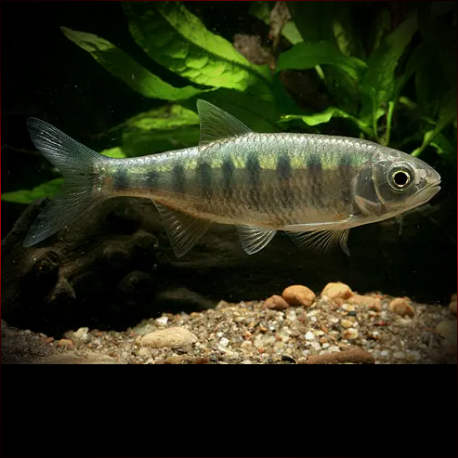More info
Datasheet
| Minimum Tank Size | 540 litres / 142.65 US gallons |
| Maximum Size | 11.0cm / 4.33inches |
| Temperature | 18°C / 64.40°F - 26°C / 78.80°F |
| Hardness | 2.02dgH / 36ppm - 12.05dgH / 215ppm |
| pH | 6.0-8.0 |
Behavior:
This species, Opsarius Ornatus, is not suited for the general community due to its specific environmental requirements and is likely to outcompete or intimidate slower-moving and less bold species during feeding times because of its fast swimming and vigorous feeding behavior. It is important to avoid much smaller fishes as they may become prey. When selecting tankmates, it is advisable to choose similarly sized, robust, pelagic cyprinids such as Dawkinsia, Barilius, or larger Devario and Rasbora species. Suitable bottom-dwellers include Garra, Crossocheilus, Botia, and Schistura species, along with many characids and loricariid catfishes. Opsarius Ornatus is gregarious by nature and forms shoals that establish a pecking order, hence maintaining them in groups of five or more individuals is crucial. Smaller groups may result in bullying of subdominant individuals, while solitary specimens can exhibit aggression towards similar-looking species.
Aquarium Setup:
To recreate the natural habitat of Opsarius Ornatus, the aquarium should mimic a flowing stream or river, with a substrate comprising variably-sized rocks, sand, fine gravel, and some larger water-worn boulders. Additional features such as driftwood roots and branches can be included to provide shelter but ensure there is enough open swimming space. Although most aquatic plants may struggle in such an environment, hardy genera like Microsorum, Bolbitis, or Anubias species can be attached to the decor. This species requires pristine water conditions with high dissolved oxygen levels and moderate water movement, necessitating the use of external filters, powerheads, and airstones. Regular water changes of 30-50% aquarium volume per week are essential, and a secure, tightly-fitting cover is crucial due to Opsarius Ornatus' jumping behavior.
Feeding and Diet:
Opsarius Ornatus primarily feeds on surface-dwelling insects both aquatic and terrestrial in the wild, supplemented with small fishes and benthic invertebrates. In captivity, they can be offered high-quality dried products along with live and frozen foods like chironomid larvae (bloodworms), Artemia, chopped earthworms, Drosophila fruit flies, and gut-loaded small crickets.
Reproduction & Dimorphism:
There is no reported information on the reproduction of Opsarius Ornatus. Adult females are typically less brightly colored, slightly larger, and thicker-bodied compared to males, especially when gravid. Sexually mature males may exhibit small tubercles on the head, body, and fins, along with reddish-orange to bronze pigmentation on the ventral portion of the body.
Habitat and Distribution:
Opsarius Ornatus is found exclusively in habitats with flowing water, ranging from sluggish streams to fast-moving rivers with substrates of sand, gravel, or mud. It coexists with species like Rasbora, Hampala, Homaloptera, and Pangio in its natural environment. The species' distribution is uncertain, with some records originating from the Tha Sae basin in Chumphon Province, southern Thailand. There are conflicting theories about its type locality, though it might have belonged to the Chao Phraya river system.

